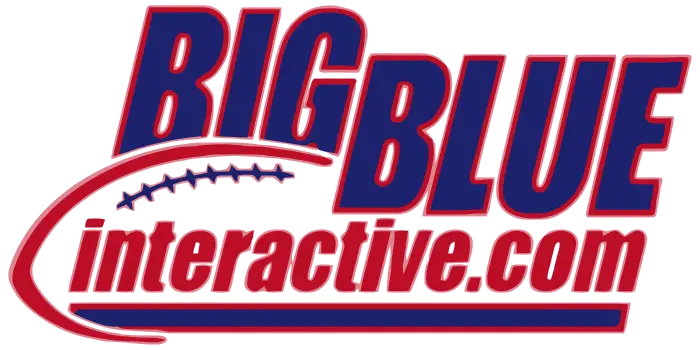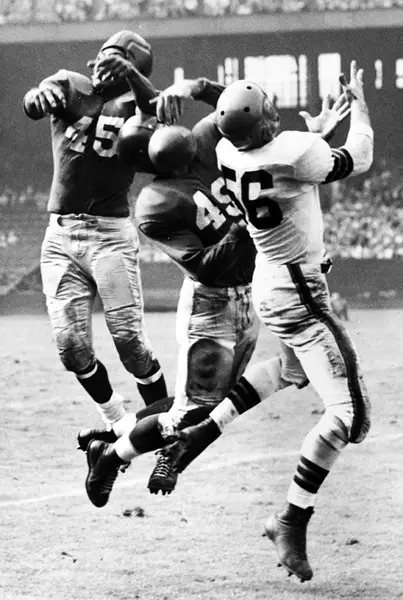New York Giants – Cleveland Browns 1950-1959 (Part I)
When most people think of a fierce rivalry, the first image to arise is often a series of intense, physical contests – two teams meeting on the field, imposing wills, doling out punishment, one trying to outlast the other. One rivalry during the NFL’s transformative stage encompassed all of that while transcending the physical scrums along the line of scrimmage. When New York and Cleveland jousted for American and Eastern Conference supremacy, the games were more than a battle of brute strength. The coaching staffs engaged in contests of creativity and attempted to outsmart one another. The game of football and its fans still reap the rewards to this very day.
The Father of Modern Professional Football
The organization and structure of football practices are now taken for granted, but it was Paul Brown’s reforms that profoundly altered the way teams prepare for football games. George Halas, a legendary innovator in his own right, credited Brown with “turning the league into an organized, highly skilled endeavor instead of a bunch of big lugs whaling the daylights out of each other.” Brown himself humbly stated his motivation for organizing his practices was to instill a sense of pride into his assistant coaches and players. He wanted them to feel that football, as a full-time occupation, was important, and something worthy of complete dedication.
Brown was strong-willed and did not waver on a conviction. “I believed strongly in the things that were necessary for us to win, and I refused to tolerate any exceptions to those beliefs.” He held his staff and players to high standards. “I always believed that young men want to work in an atmosphere of reasoned discipline and order, and respond better under those conditions.” As a result, the following major innovations that Brown began not only changed the way football was played, but how it was perceived by the general public:
- Full-time player scouting
- Character was as equally important as athletic skill; “selfish or disloyal, or those who could not adjust their individual skills to our team concepts” were dismissed from consideration
- “The ability to perform under pressure is the mark of a great player”
- Standardized the 40-yard dash after calculating the average distance needed to cover a punt, the most repeated play in football
- Film study
- Not only of opponents, but self-scouting and recognizing his team’s own tendencies
- Playbooks
- Players were required to take notes during meetings and routinely quizzed to gauge their retention
- If players understood why they were doing something, “they were more apt to be in the spirit of the occasion”
- Took play-calling duties away from the quarterback
- Initially sent plays in by rotating offensive guards; later pioneered the use of transistor radios in the quarterback’s helmet
- Provided the quarterback with “check-with-me” calls to use at the line of scrimmage if the defense’s alignment was unfavorable
- Instituted a year-round conditioning plan
- Racially re-integrated professional football
- Brought Marion Motley and Bill Willis to the Browns in 1946; no black players had been on an NFL roster since 1934
- Meticulously pre-planned practices
- Handed out itineraries to players
- Morning practice would be spent on all aspects of a single rushing play, then afternoon practice on a passing play
- Designed an attacking passing offense
- Conceptualized read-and-react option routes (today known as ”option routes”) and timing patterns
- Analyzed the geometry of the football field, exploiting open space by spreading defenses away from the line of scrimmage
- Taught offensive linemen to block passively on pass plays, forming a ”pocket” for the quarterback
- Conceptualized zone blocking for the offensive line to maximize the capabilities of fullback Jim Brown
More than anything, Brown was passionate about teaching. The list of men who played under and coached alongside Brown, eventually finding their own success as head coaches, is unparalleled:
- Weeb Ewbank
- Lou Saban
- Blanton Collier
- Don Shula
- Chuck Noll
- Don McCafferty
- Bill Walsh
Brown was tagged as football’s first “genius,” a title he disdained, even if it was merited. His colleagues did not dispute it. They knew they had to be prepared and have their teams performing at their best when they faced Cleveland, and that is what served to further the game of football more than anything else. Head coaches did not want to be embarrassed. They readily adopted Brown’s practices and spent extra time studying film, developing counter plans as they anticipated how Brown would try to beat them. Brown inspired innovation among his colleagues, which is possibly the greatest of all possible legacies.
An Unlikely Protagonist
Giants’ head coach Steve Owen had enjoyed a great run with his team from 1933 through 1946, winning eight Eastern Division titles and two NFL Championships. During his tenure, New York made playing defense a brutal art form. Owen pioneered defenders playing off of the line of scrimmage when most teams deployed seven-man lines and relied on safeties to clean up on ball carriers who may have slipped through cracks in the front wall. Hall of Fame center and linebacker extraordinaire Mel Hein recalled, “Owen brought in the 5-3-3 in 1937 and we first used it extensively in 1938. The 5-3-3 was especially effective against Chicago’s T-Formation. Since we had linebackers left, right and center, none of us had to go running after the first fake. We could wait in our positions to see if the play was coming. Also, we ran stunts from this defense, with the linebackers and linemen crisscrossing as they rushed.”
Passing offense innovations accelerated with the arrival of precision quarterbacks such as Washington’s Sammy Baugh and Chicago’s Sid Luckman. Deft receivers like Don Hutson caused problems for defenses packed near the scrimmage line. Large, slow linebackers were exposed in coverage. Many teams adopted Earle “Greasy” Neale’s 5-2-4 Philadelphia Eagle defensive alignment that became known as the Eagle Defense. Earle said, “This defense was most effective against the tight T-Formation. A man-in-motion or a flanker spread it out.” The four defensive backs covered more of the field, but it would soon be discovered that this defense was still vulnerable.
The Giants were mired in a malaise of decline when the All-America Football Conference (AAFC) merged with the established league prior to the 1950 season. Realignment brought change and new challenges. The Eastern Division was rechristened the American Conference when it inherited the four-time champions of the rival league. The Browns’ 52-4-3 legacy, which included professional football’s first perfect season [15-0] in 1948, preceded them, even if NFL stalwarts were loath to recognize their accomplishments.
Owen’s football roots were firmly grounded in single-wing style formations, having a hand in the dirt and winning the battle on the line of scrimmage. He hadn’t brought a new offensive concept to the game since his A-Formation in the early 1930’s and the Giants were among the last teams to resist adapting to the modern T-Formation.
Defensive coaching was minimal in the late 1940’s. Teams met as large groups and 80% of the meetings and practices were spent on offense. Defenses lined up at the line of scrimmage, beat the man in front of them, and then pursued the ball carrier. There was little or no anticipation whatsoever. Aside from accounting for a man in motion, pre-snap defensive alignments did not change.
The Umbrella Opens
Brown proved to be a catalyst for change. Knowing he would face Cleveland twice every season, Owen spent the offseason studying game film of his new opponent. Owen had the foresight to realize brute force was not enough to get the job done against this “finesse” team. He needed to account for the open spaces on the football field. The Giants played a 6-1 defensive front, and Owen took advantage of the talent on his roster, knowing he had rangy, athletic defensive ends. They would align in their standard front, but at the snap of the ball the ends would drop out and cover the flats, while the defensive halfbacks would retreat. The two safeties covered the deep middle, and the result was an umbrella-like coverage. He thought this would serve the dual purpose of controlling the Browns’ precise passing attack while still being able to defend bruising fullback Marion Motley.
The scheme looked great on paper. Fortunately the Giants received a small bonanza of their own from the AAFC that made it come to life on the field. The New York Yankees were one of the teams that gave the Browns some competition during their four-year reign. Although they never defeated Cleveland, New York tied them once in 1947 and opposed the Browns twice in the AAFC Championship Game, nearly defeating them in 1946 before an Otto Graham-led 4th quarter comeback sent the Yankees home with a 14-9 defeat. The strength of the Yankee team was its defense, and Owen’s umbrella was supported by four newcomers from the Yankees: Arnie Weinmeister, Otto Schnellbacher, Harmon Rowe, and Tom Landry.
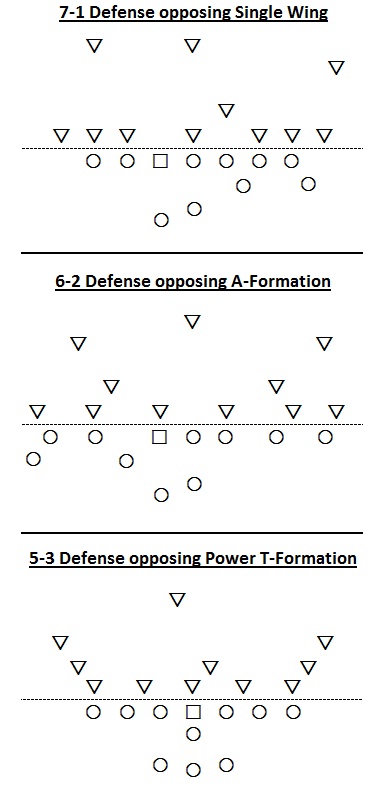 Weinmeister was a rare physical specimen. At 6’4” and 240 pounds, he had the strength to consistently win skirmishes in the trenches, but it was his fluid athletic ability, speed, and the desire to dominate that set him apart. He regularly terrorized quarterbacks in the pocket and tackled backs and receivers downfield. When Weinmeister joined the Giants, he told Owen the way to defeat Cleveland was “to knock them on their butts.” Weinmeister and fellow tackle Al DeRogatis were charged with crashing the pocket on pass plays, and funneling Motley to linebacker John Cannady on rushes.
Weinmeister was a rare physical specimen. At 6’4” and 240 pounds, he had the strength to consistently win skirmishes in the trenches, but it was his fluid athletic ability, speed, and the desire to dominate that set him apart. He regularly terrorized quarterbacks in the pocket and tackled backs and receivers downfield. When Weinmeister joined the Giants, he told Owen the way to defeat Cleveland was “to knock them on their butts.” Weinmeister and fellow tackle Al DeRogatis were charged with crashing the pocket on pass plays, and funneling Motley to linebacker John Cannady on rushes.
Schnellbacher, Rowe, and Landry formed a unique blend of talents with Emlen Tunnell and were the key to the success of Owen’s strategy. Defensive halfbacks Landry and Rowe played with solid technique and rarely gambled in their coverage. Tunnell had great range and ball instincts. He often freelanced through the secondary, and usually had the speed to recover from a misread. Schnellbacher combined instincts with technique. What set them apart as a unit was all four were exceptional tacklers. Tunnell recalled years later, “That was the best tackling backfield I ever saw. Everyone knew what the other fellow was going to do and that’s what made it so much fun.”
The two-time defending NFL Champion Eagles did not have much fun when they faced Cleveland on Saturday night of the NFL’s showcase opener. The pro passing game was relatively unsophisticated at this point, and Brown took a quantum step forward for this game by splitting both his ends wide on the line of scrimmage. Brown believed, “You had to integrate the running game with an intelligently conceived passing offense to win in pro football.” He also refused to allow the defense to dictate where the ball would be thrown.
Neale’s Eagle Defense was subsequently shredded by quarterback Graham’s sharp passes to ends Mac Speedie and Dante Lavelli. When Neale adjusted by having his two linebackers cover the flats, Graham had Motley pound into the undefended middle. When the linebackers pinched in, Graham sent halfback Dub Jones around end to catch a pass in the short middle or sent Motley wide on a sweep. After the 35-10 thumping, NFL Commissioner Bert Bell congratulated Brown and told him Cleveland was, “the most intensely coached team I have ever seen.”
The Giants opened their season the next day in Pittsburgh and beat the Steelers 18-7, playing their standard defense, as Owen dared not tip his hand to the shrewd Brown. The schedule makers did New York a tremendous favor by giving them a bye for Week 2. The Browns traveled to Baltimore and whipped the Colts 31-0 while Owen drilled his new scheme to perfection at practice.
The Giants visited Cleveland in Week 3, and the results of the new defense were so profound they may have even shocked Owen himself. As New York’s defense came to the line, they showed a standard 6-1 front. At the snap, the ends quickly dropped to cover the flats and the defensive halfbacks dropped to cover the deep sidelines while the safeties covered the middle. The four down linemen attacked the backfield while the linebacker spied on Motley. The Browns were unprepared but, more surprisingly, were slow to respond to the strategy.
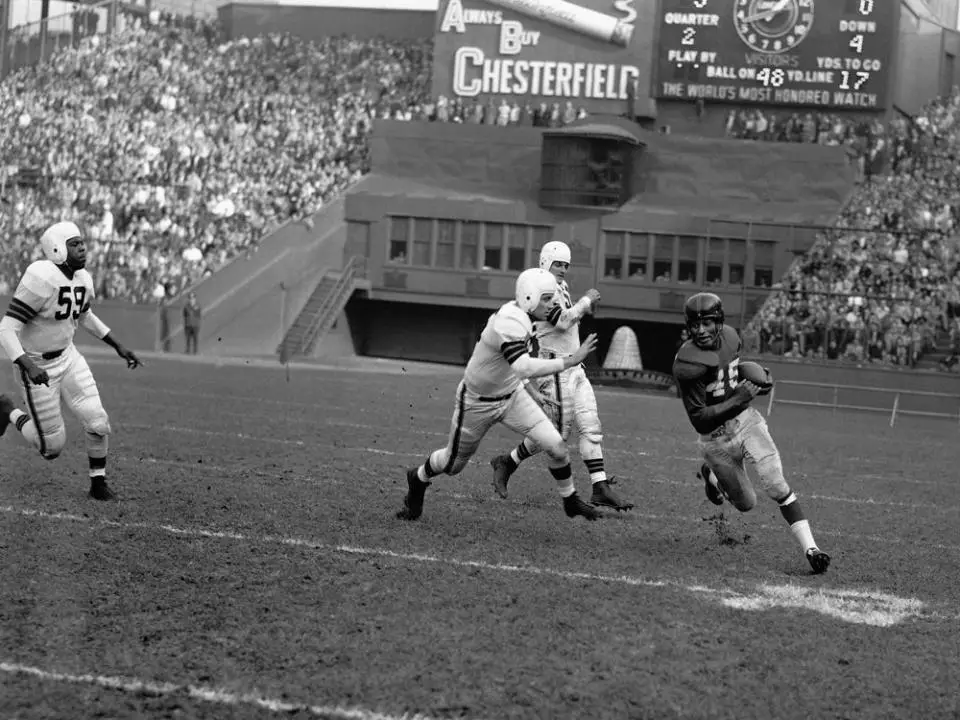
Emlen Tunnell (45), New York Giants (November 18, 1951)
Graham did not complete a single pass in the first half and was intercepted three times. The Cleveland fans, so used to seeing their team trounce the opposition, booed their team as they went into the locker room trailing 6-0. In the second half, Owen anticipated Brown altering his strategy. Cleveland came out in the third quarter shortening the pass routes of the ends and running wide, but Owen had closed the Umbrella, blitzing his defensive backs, pressuring Graham, and plugging any rushing lanes. The 6-0 score held up, marking the first time the Browns had ever been held scoreless. So impressed was the multi-talented Tunnell, he later said, “We did such a job that afternoon that I never again wanted to play offense.”
Tunnell still clearly recalled the details years later when he was a Giants’ assistant coach, “In 1950 we developed a defense against the Browns that came to be known as the Umbrella. Our ends, Jim Duncan and Ray Poole, would drift back and cover the flats while tackles Arnie Weinmeister and Al DeRogatis and guards Jon Baker and John Mastrangelo were charged with rushing the passer and containing the run. The lone linebacker, John Cannady, was told to follow the Brown fullback wherever he went. Tom Landry played the left corner, Harmon Rowe the right, I was the strong safety and Otto Schnellbacher the weak. If you would look at this alignment from high in the stands it looked like an opened umbrella. In truth, it was the same 4-3-2-2 used today. We did go into other formations, but mostly we used this 4-3 arrangement. It was so successful against the Browns that we beat them twice. The first time we played them we shut them out, the first time that had ever happened to them.”
Given the challenges Cleveland’s offense presented, DeRogatis explained the defense’s strategic goals. “The modern 4-3-4 defense came into being largely because of the fantastic ability of the old Cleveland Browns to make a defense look bad. With great ends, a great blocking and running fullback, and a phenomenal quarterback, the Browns, coached by Paul Brown moved with awesome finesse over almost everyone they met. As a result, Steve Owen devised the Umbrella Defense, which dropped the standard six-man defensive line, to go to at least a version of the 4-3-4 which most teams use now. Against the standard six, the receivers could beat you short; the swing could wreck you outside; the fullback forced you to protect the middle; and the quarterback, who could do anything, passed, ran, screened, drew, and kept you off balance. So the 4-3-4 was born and almost revolutionized the game.”
The teams met for a rematch in front of 41,734 enthusiastic fans at the Polo Grounds three weeks later. The 4-1 Browns punctured the 4-1 Giants’ Umbrella with 13 second-quarter points. The final seven came seconds before the half following a major mental error by New York return-man Jim Ostendarp. On the kickoff following a Lou Groza field goal, Ostendarp let the ball hit the ground and roll to the one-yard line, where Cleveland recovered. Graham plunged for the touchdown on the next play to increase Cleveland’s lead to 13-3.
Owen altered his defensive strategy for the second half after Weinmeister left the game with a knee injury. Instead of having the ends drop off in the Umbrella they rushed Graham relentlessly. Poole and DeRogatis harassed Graham, who completed just four passes and lost 71 yards in sacks over the final 30 minutes. Cleveland crossed midfield just once. The Giants’ offense completed the comeback on a bit of razzle-dazzle when quarterback Charlie Conerly faked a hand-off to Eddie Price and flipped the ball behind his back to Joe Scott who raced around end for an uncontested touchdown and a 17-13 win.
Weinmeister boasted after the game, “We were smarter and better. We proved that defense was more important than offense. A lot of people thought the first win was a fluke. We knew it wasn’t and we were determined to prove it to everybody else.”
Cleveland rolled through the remainder of their schedule unblemished. The Giants fell flat versus the Chicago Cardinals the week after their victory over the Browns. The ship was righted quickly, and New York won impressively the rest of the way, including an amazing run where they scored 50 points three times in four weeks. The Giants and Browns finished tied atop the American Conference with 10-2 records, necessitating a playoff in Cleveland.
Bitterly cold temperatures limited attendance to 33,054 fans. The field was frozen and Owen obviously recalled how basketball shoes helped his underdog Giants pull off an upset against the heavily-favored Chicago Bears in 1934. He brought enough on the trip so the entire squad would be outfitted for the full 60 minutes. The master of preparation Brown would not be outdone; Cleveland took the field in black Chuck Taylors.
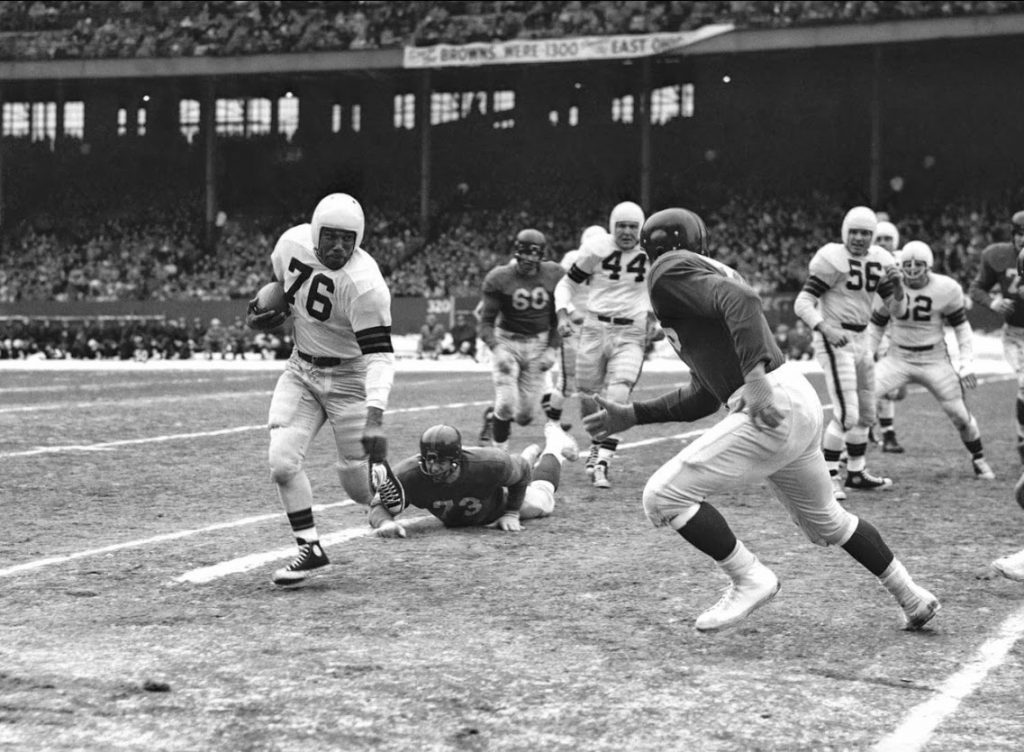
New York Giants at Cleveland Browns (December 17, 1950)
After the Browns went up 3-0 early in the first quarter, both defenses took control. The icy field made it impossible for backs and receivers to cut sharply, and for passers Graham, Conerly, and Travis Tidwell (Giants) to plant and throw. The teams would combine for just six pass completions and 91 passing yards for the entire game. Owen mixed the A-Formation with the T-Formation throughout the first half, before committing solely the A for the second half
Five minutes into fourth quarter, New York’s Gene “Choo Choo” Roberts whipped around right end with interference in front of him. Before he could reach the end zone, Roberts was caught from behind on the Cleveland 4-yard line by Bill Willis after a gain of 32 yards. Two plunges by Price netted just a single yard (Willis was in on both tackles). On third-and-goal from the three, Conerly tossed a touchdown to end Bob McChesney, but the Giants were flagged for a false start. On the next play, Conerly’s pass was intercepted, but Cleveland was called for defensive holding. The Browns’ fans were in a full-throated frenzy, on their feet chanting “Hold that line!” as they exhorted their defense.
On first and goal from the four, Price ran for one, but the Giants were penalized for an illegal snap. On second and goal from the eight, Joe Scott was tackled for a five-yard loss by Willis. Conerly’s third-down pass was deflected incomplete and the Giants settled for a field goal and 3-3 tie after the frustrating series.
Taking possession with 6:10 left in the game, Graham led the Browns on a march downfield, including three Graham rushes for 36 yards. However, like the Giants on the previous series, Cleveland settled for a field goal after having a goal-to-go situation. With time on the clock for one last desperate drive, Conerly was tackled in the end zone for a safety, completing the Browns’ quest for revenge on the only team to defeat them in the 1950 season. Cleveland went on to defeat the Los Angeles Rams (who ironically had left the city of Cleveland following an NFL Championship in 1945) in one of the most thrilling championship games in history, 30-28.
Despite falling short in the playoff game, the Giants’ three-game series with the Browns that season had to be considered a success. In 180 total minutes played, Owen’s Umbrella Defense surrendered only one touchdown to an offense that routinely piled up points against the rest of the league. The Browns led the American Conference with 310 points scored, and their average margin of victory was just over 13 points. In their three games against New York, their aggregate 21 points came from the lone touchdown, four field goals, and a safety from their defense.
Brown poked some holes in Owen’s Umbrella the next season. Cleveland swept the season series with New York, won the American Conference title but lost to the Detroit Lions in the NFL Championship game. In 1952 the Giants swept the Browns, but Cleveland three-peated as conference champs, and lost again to Detroit. The significance of these two campaigns came to full fruition in 1953. While Brown furthered the offense of the future, developing and expanding the roles of the Split End and Flanker in T-Formation variations, Owen never fully adapted to the T-Formation, and continually reverted to his familiar A-Formation. This stunted the development of quarterback Conerly.
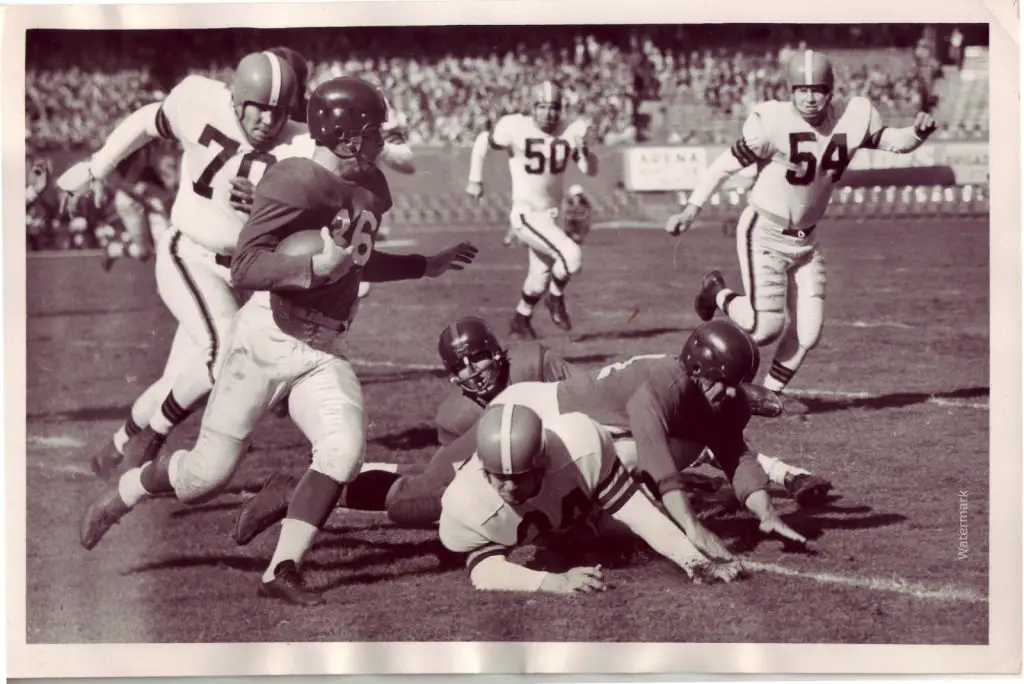
New York Giants at Cleveland Browns (October 12, 1952)
The nadir came in an ugly 62-14 December loss to Cleveland at the Polo Grounds that was so bad even backup quarterback George Ratterman threw a touchdown pass in the fourth quarter after Graham had been pulled. The Giants’ leadership was forced to admit their 23-year steward for the franchise needed to retire. The archaic offense was inept, scoring a meager 179 points over the 12-game season. The once-formidable defense was ragged; the league caught up to the Umbrella scheme and there was no counter strategy on the horizon. The locker room was despondent; many players contemplated early retirement.
Multi-threat performer Frank Gifford, who played both ways and averaged 50 minutes per game at the end of the season while the Giants struggled with injuries, recalled, “The last five games of 1953, I didn’t come out. I played offense and defense; I was kicking off, running back punts, kicking field goals. I was really questioning whether to come back in 1954.” A significant part of Gifford’s frustration was the inability of Owen to figure out a role that maximized his abilities. Gifford had been a star tailback for USC in college, but Owen relegated him to defensive halfback. “I would have cut the good looking son-of-a-bitch if he hadn’t been our top draft pick,” said Owen.
Quarterback Conerly, who was the NFL Rookie of the year in 1948, would turn 34 the next season. He was tired of being beaten up not only on the field behind a faltering offensive line, but by the booing Polo Grounds fans who hung up signs reading “Back to the Farm Charlie.”
